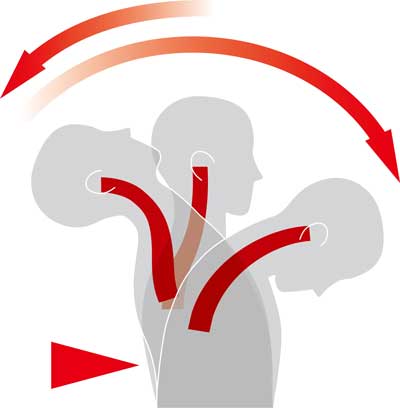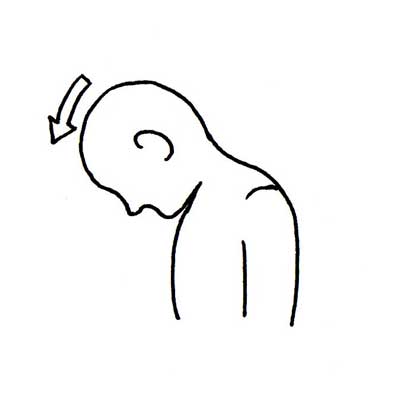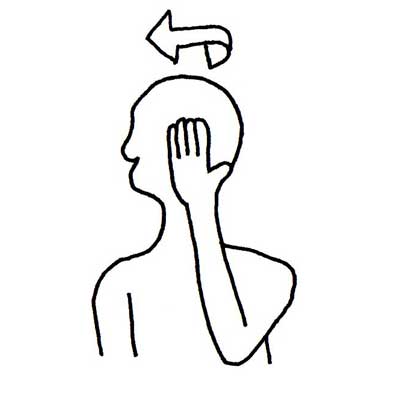Whiplash – What Should I Do?
Physiotherapy Exercises and Advice for Neck Whiplash
‘Whiplash’ is a familiar term for most people. It can happen in any area of your body but is most common in your neck. It is an injury that occurs when your spine goes through a sudden, forceful movement into an overstretched position.
We generally think of whiplash as the result of a car accident. As you can see in the picture below, when you receive an impact from behind, your head and neck move from a central resting position into a sudden acceleration/deceleration motion which, takes your neck first into hyperextension and then into hyperflexion. However, whiplash can also develop from a number of other causes, such as during sports (for example diving, swimming, rugby, boxing, horse riding, snowboarding) or from a fall.
You may find that you feel ok directly after the incident. It is very common to find that pain and stiffness in your spine and surrounding muscles then gradually increases over the next few hours or days. You may also experience some dizziness, headaches, or pins and needles/numbness down your arms.
If you are experiencing whiplash, try the following advice. The correct care early on can make a huge difference in how quickly you recover.
Early Advice for Whiplash
- Movement – the most important thing to remember is to keep moving your neck gently. Your neck will start to feel stiff if you remain still for a while. Try to move your neck in all directions, regularly throughout the day. Stay within a comfortable range of movement, nudging gently into a mild stretch sensation, but don’t push right through the pain and don’t push into a position that gives you pins and needles or numbness down your arms. The movements may feel a little sore, but it won’t cause any damage. Little and often is the key to success! Try 15 – 20 seconds of movement every half hour.
- Avoid using a neck brace or collar – unless advised by a health professional, you should avoid using a neck brace or collar to support your neck after a whiplash injury. Keeping your neck still for long periods of time will actually increase your pain and stiffness.
- Pain control medication – adequate pain relief is very important in the early stages of whiplash. Regular pain control will help to reduce muscle spasm and allow your neck to move more easily. This in turn helps you regain your movement faster. Your GP may prescribe you some pain control, anti-inflammatories or muscle relaxants for the first couple of weeks. Make sure you take these regularly.
- Heat or ice – try using a wheat bag or hot water bottle over the painful area a few times a day. This will help to relax tight muscles and may offer some pain relief. If you are struggling with your neck movements, try putting some heat on the area for 10 minutes before you do the exercises. Some people do prefer to use ice instead of heat. This is completely fine too, but make sure the ice is wrapped in a plastic bag and remove the ice as soon as the area goes numb, otherwise you may risk an ice burn.
- Massage – gently massaging (or getting someone else to massage) the muscles around your neck and shoulders can also really help to increase your movement and reduce your pain. Make sure any massage is gentle, avoid deep massages or sports massages in the early days.
- Sleeping – try to avoid sleeping on your front for the first few weeks after whiplash. Sleeping on your side is normally more comfortable.
- Continue normal everyday activities – continuing with your normal activities can actually speed up your recovery, though you may need to modify things a bit to start with. Try to keep doing any activities that feel comfortable or cause only mild, short-term discomfort. Modify any activities that feel a bit too painful. Every day you should be able to do a little bit more.
Exercises for Whiplash
Neck Forward Bend
Move your chin down to your chest then return to the start.
Neck Rotation
Sitting up tall, turn your head to look over one shoulder then return to the start. Repeat to the other side. Try to keep your head level – track a horizontal line round with your eyes.
Neck Side Bend
Sitting up tall, tip your ear towards one shoulder. You can use your arm to help guide the movement. Return to the start and repeat to the other side.
Upper Back Rotation
Sitting up tall on a chair with your arms crossed, turn your upper body round to one side. Return to the start and repeat to the other side.
A few things to note:
If you experience any combination of dizziness, double vision, difficulty speaking, difficulty swallowing, fainting or collapse, significant nausea, numbness around your mouth, lips or tongue, a metallic taste in your mouth or difficulty controlling your legs, then urgent medical advice is required. Please go straight to your local A&E department.
If you are experiencing pins and needles or numbness down your arms, or a feeling of weakness in your arms but none of the above symptoms, please contact your GP or local physiotherapist to discuss your symptoms.
Key Message:
Keep moving!!! This is the most important thing to remember. Gentle regular movement will speed up your recovery. Try not to worry about your symptoms, most people make a good recovery, with symptoms improving within a few weeks even when they experience high levels of pain to start with.
If your symptoms are not showing good improvement after 6 weeks, book an appointment with your GP, or contact your local physiotherapist.
If you would like further advice on whiplash, give us a call on 07702 847036 and speak directly to a Chartered Physiotherapist or click the ‘Book Online’ button to make an appointment.
The Nebula Physio and Wellbeing Team










